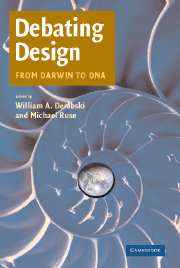Book contents
- Frontmatter
- Contents
- Notes on Contributors
- Debating Design
- INTRODUCTION
- PART I DARWINISM
- PART II COMPLEX SELF-ORGANIZATION
- PART III THEISTIC EVOLUTION
- 12 Darwin, Design, and Divine Providence
- 13 The Inbuilt Potentiality of Creation
- 14 Theistic Evolution
- 15 Intelligent Design
- 16 The Argument from Laws of Nature Reassessed
- PART IV INTELLIGENT DESIGN
- Index
- References
13 - The Inbuilt Potentiality of Creation
Published online by Cambridge University Press: 05 June 2012
- Frontmatter
- Contents
- Notes on Contributors
- Debating Design
- INTRODUCTION
- PART I DARWINISM
- PART II COMPLEX SELF-ORGANIZATION
- PART III THEISTIC EVOLUTION
- 12 Darwin, Design, and Divine Providence
- 13 The Inbuilt Potentiality of Creation
- 14 Theistic Evolution
- 15 Intelligent Design
- 16 The Argument from Laws of Nature Reassessed
- PART IV INTELLIGENT DESIGN
- Index
- References
Summary
Our understanding of the very early universe tells us that we live in a world that seems to have originated some fourteen billion years ago from a very simple state. The small, hot, almost uniform expanding ball of energy that is the cosmologist's picture of the universe a fraction of a second after the Big Bang has turned into a world of rich and diversified complexity – the home of saints and scientists. Although, as far as we know, carbon-based life appeared only after about ten billion years of cosmic history, and self-conscious life after fourteen billion years, there is a real sense in which the universe was pregnant with life from the earliest epoch.
ANTHROPIC FINE-TUNING
One can say this because, although the actual realisation of life has proceeded through an evolutionary process with many contingent features (the role of “chance”), it has also unfolded in an environment of lawful regularity of a very particular kind (the role of “necessity”). The so-called Anthropic Principle (Barrow and Tipler 1986; Leslie 1989) refers to a collection of scientific insights that indicate that necessity had to take a very specific form if carbon-based life were ever to be a cosmic possibility. In other words, it would not have been enough to have rolled the evolutionary dice a sufficient number of times for life to have developed somewhere in the universe.
- Type
- Chapter
- Information
- Debating DesignFrom Darwin to DNA, pp. 246 - 260Publisher: Cambridge University PressPrint publication year: 2004
References
- 3
- Cited by



